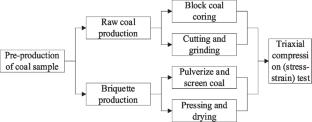Comparative research on the precursory characteristics of critical slowing down before the failure of raw coal and briquettes
Abstract
Acoustic emissions (AE) generated during the deformation process of coal rock reflects the stress and failure state of the coal rock mass. AE parameters were used to identify precursor information indicating the critical transition before failure in coal rock masses. It was of significant importance in rock mechanics and engineering. The triaxial loading and AE detection tests were performed on raw coal and briquettes. The variation characteristics of AE characteristic parameters (RA/AF, duration, and rise time) during the test damage and failure process of raw coal and briquettes were statistically analyzed. The AE precursor characterization of critical failure in raw coal and briquettes was investigated using the critical slowing down theory. Compared to the autocorrelation coefficient, variance change points were easier to identify and were not influenced by the choice of lag lengths. The t variance and autocorrelation coefficient of AE RA/AF, duration, and rise time were used as the main criterion and auxiliary criterion for the transformation of raw-coal instability failure. They were not recommended to be used as early warning information of briquettes’ instability failure. The failure precursory signals of raw coal and briquettes obtained through critical slowing down had good timeliness, which was of great significance to the monitoring and early warning of coal rock masses.


 求助内容:
求助内容: 应助结果提醒方式:
应助结果提醒方式:


